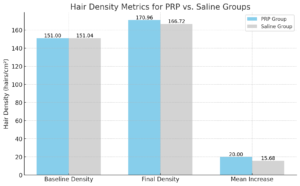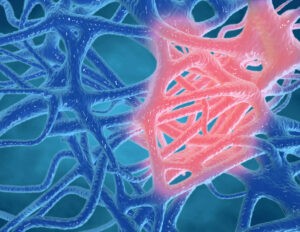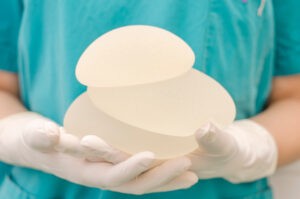
If you’ve been researching options for hair restoration, you may have come across Platelet-Rich Plasma (PRP) therapy. PRP is a cutting-edge, minimally invasive solution that’s generating considerable interest for its potential to combat hair loss and boost hair growth. This therapy doesn’t just promise results; it delivers a scientifically backed approach to hair restoration, making it popular among people with androgenetic alopecia (AGA), a common cause of hair thinning and balding.
Typically, PRP results are best appreciated over time, with “before and after” photos capturing gradual improvements. But what if you could see measurable changes in just three months? A recent study took a close look at PRP’s effectiveness at the three-month mark, offering insight into its short-term impact on hair density.
How the Study Was Designed to Test PRP’s Impact
This study used a rigorous, well-structured approach known as a split-scalp design to test PRP’s effectiveness for hair growth. Thirty-five individuals with AGA were included, and each participant’s scalp was divided into two 7.6 cm x 7.6 cm areas—one side treated with PRP injections, and the other with a saline placebo. This setup allowed researchers to directly compare the results within each individual, eliminating many external variables that can impact hair growth.
Over three months, participants received three monthly PRP sessions, followed by an evaluation three months after the final treatment. The findings were clear: PRP significantly increased hair density in treated areas, making it a promising option for anyone looking to improve hair fullness in a relatively short timeframe.
How PRP Stands Out: A Closer Look at the Data
In the study, hair density in the PRP-treated area increased from 151 hairs per square centimeter to 170.96 hairs/cm²—an average increase of about 20 hairs/cm² over three months. The placebo-treated area, however, also saw a slight density increase, from 151 to 166 hairs/cm².
While the density increase on both sides may seem similar at a glance, several factors suggest that PRP plays a unique role in hair growth stimulation. Here’s what makes PRP a standout option:
- PRP as a Growth-Enhancing Agent: PRP is packed with growth factors and cytokines that specifically target dormant hair follicles, encouraging them to re-enter the active growth phase. This targeted action sets PRP apart from the mild response often seen with placebos and likely accounts for the steady and consistent increase in hair density noted with each session.
- Precision and Depth of PRP Delivery: Each PRP injection penetrates the scalp at specific depths where hair follicles are most receptive to growth signals. Unlike topical treatments, which have limited penetration, PRP injections give direct access to hair follicle cells, activating the regenerative mechanisms that help sustain and even multiply hair follicles. This direct action allows PRP to work on a cellular level that most over-the-counter products can’t reach.
- Sustained and Cumulative Effects: PRP therapy builds upon itself with each session. This means that the results from one session are reinforced and boosted by the next. Over a period of three months, this cumulative effect can make a significant difference in density, especially for those dealing with mild to moderate hair thinning.

Graph created in collaboration between Nuveau and SEO Agency Round II Media
Interpreting Hair Density Changes: Why Both PRP and Saline Showed Growth
The bar chart above shows that both the PRP and saline groups experienced hair density increases, which may prompt questions about whether PRP provides a unique advantage. However, this is a common response in hair loss treatments, and here’s why PRP remains the superior option:
- Micro injury Effect: Saline injections, much like PRP, involve micro injections directly into the scalp. These tiny “micro injuries” can temporarily stimulate hair growth by improving blood flow to the area and prompting a mild, localized healing response. The body may release small amounts of growth factors as part of this process, but this effect is usually short-lived and mild compared to PRP’s more sustainable impact.
- Distinct Mechanism of PRP: Unlike saline, PRP is loaded with concentrated platelets from the patient’s own blood, delivering a rich mix of growth factors directly to hair follicles. These growth factors target dormant follicles and encourage them to produce new hair. This isn’t a fleeting boost—PRP initiates ongoing hair follicle activation that saline alone cannot sustain, which is why the PRP-treated side saw a consistently higher density boost.
- Compounding Effects Over Time: The study results suggest that the PRP-treated areas maintained a more substantial hair density increase over time. If PRP sessions are continued, these cumulative benefits can build on one another, yielding even better results. By contrast, saline’s benefits are generally limited to the short-term response to micro injuries and tend to plateau without further improvement.
- Realistic Expectations for PRP: While PRP is highly effective and shows strong results, it remains a non-surgical solution. This means that improvements in hair fullness will look natural and grow gradually. The data underscores PRP’s ability to boost hair density relatively quickly, making it an attractive option for those looking for realistic yet impactful results without surgery. For patients seeking more dramatic changes, ongoing sessions may continue to build on initial results.
A Non-Surgical, Natural Solution for Fuller Hair
In short, while both treatments resulted in some growth, PRP’s unique regenerative properties make it a powerful option for anyone looking to increase hair density naturally. The study confirms that PRP’s targeted approach, using growth factors from your own body, can lead to meaningful results, even within a short timeframe. Plus, PRP has a low risk of adverse effects, making it a safe choice for most individuals.
So, if you’re searching for a non-surgical solution to boost your hair’s fullness, PRP could be a worthwhile option. Consulting a hair restoration expert can help you determine the best treatment plan based on your individual needs and goals.
Ready to Explore PRP for Hair Restoration?
At Nuveau, our team of specialists uses the latest techniques for hair restoration, including PRP therapy. Our personalized approach ensures that your journey is tailored to help you achieve optimal results. Contact us today to learn more about how PRP can enhance your hair growth journey and help you regain confidence in your hair’s appearance.

